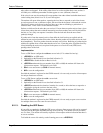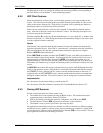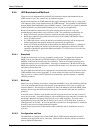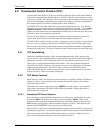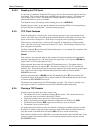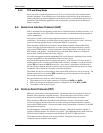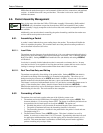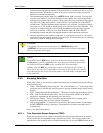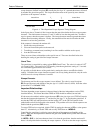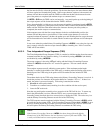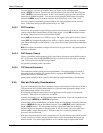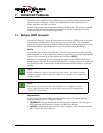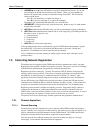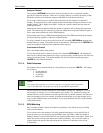
Feature Reference DART 300 Modem
Page 48 2110212 Rev 1.0
escape character (defined in register S2), usually the plus sign “+”, repeated three times; followed
by another idle guard time period. The escape characters must not be spaced by more than the
guard time or the sequence is broken.
+++
Transmit Data
Guard Time
Guard TimeT
1
T
2
Figure 6-1: Time Dependent Escape Sequence Timing Diagram.
In the figure above, Transmit is idle for more than the guard time before the first escape sequence
character. The time between characters (T
1
and T
2
) must be less than the guard time. If either is
equal or greater, then the sequence is broken. The escape character must be repeated three times
without other intervening characters. Finally, the transmit data line must be idle after the third
character for at least the guard time.
If the sequence is detected, the modem will:
1. Discard the escape characters.
2. Close and forward the packet to the network.
3. Transition to command state (remaining in on-line condition with the session open).
4. Issue the OK result code.
There are several inter-relationships to take special note of. These are described below after
detailing the setting of guard time and escape character.
Guard Time
The guard time is controlled by setting register S12 (Guard Time). The value is in units of 1/50
th
of a second (0.02s). The range is 0 to 255 meaning a maximum guard time setting of 5.1 seconds
and a minimum applied time of 0.02 seconds.
It is possible to disable the use of the guard time by setting the value to zero (0) (the default
setting). If disabled, the escape character sequence can use any timing whatsoever; only the series
of three successive escape characters is needed.
Escape Character
The character used for this escape sequence is user defined. The value is stored in register
S2 (Escape Character) and defaults to the plus sign “+” (ASCII value 43, 0x2B). Note that values
greater than 127 will disable TDES.
Important Relationships
The time dependent escape sequence is detected ahead of the time independent version (TIES,
described below). This means that either TDES or TIES should be enabled, but not both.
If both were to be enabled, and the escape character (S2) is the plus sign, use of TIES will require
that the time between the uppercase “T” and the first plus sign “+” be less than the guard time. If
not then the TDES will take precedence and the leading “AT” in the TIES will remain in the
packet buffer and will be forwarded to the network. This problem will occur if both sequences are
enabled and the guard time (S12) is zero.
To ensure TIES can be recognized, disable TDES by setting the character in S2 to a value greater
than 127. Alternatively, to disable TIES and use only TDES then set +WS60=0.
Controlling the guard time is critical to proper detection of the sequence and handling of the
packet. There are interdependencies between the guard time (S12) and the packet inter-character
timer (+WS70).
If +WS70 < S12, i.e. the inter-character timer is less than the guard time, then the modem will
detect a closed packet before detecting the escape sequence. In order to start the escape sequence,



